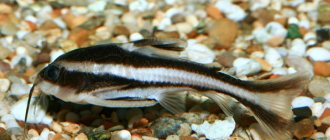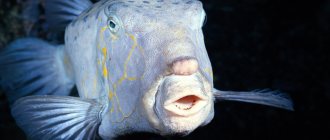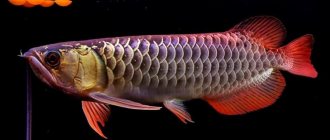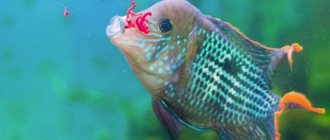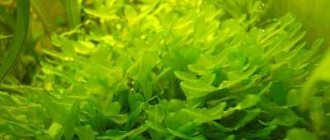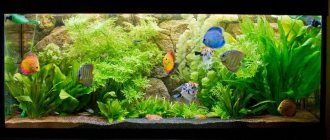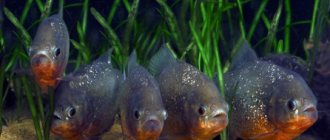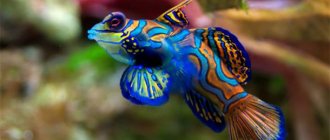Viviparous fish, or “livebearers” as they are called, are one of the most popular creatures that people choose as pets. Based on the name, you can understand that they do not lay eggs, but release fully formed offspring.
Viviparous animals are the most unpretentious and hardy, which is why there is such interest in them, which is growing every year. The number of species of viviparous fish is in the hundreds; in this article we will consider the most popular of them.
sword bearer
Swordtails lead a group lifestyle, so for their comfortable existence it is necessary to purchase 7-9 individuals. It should be remembered that there must be at least 2 females per male. They grow up to 10 cm, so they cannot be kept in a small aquarium. The minimum volume for a comfortable existence is 10 liters per individual.
The interesting thing is that they are quite good jumpers and if one day you don’t want to find your pet on the floor, then you must definitely purchase a cover.
The best habitat for Swordtails is natural shelters. Algae, driftwood, stones - all this can be used in arranging an aquarium.
Loves clean and oxygenated water, so take care of a good and high-quality filter and compressor. The light should not be sharp and bright, but diffused, because Swordbearers are quite shy and afraid of harsh light. Add floating seaweed with wide leaves to create shade. Pebbles or sand can be used as soil.
Parameters for a comfortable existence:
- temperature from +20-28° C;
- acidity from 7-8 pH;
- hardness from 9-25° dH.
Good neighbors: Molinesia, Pecilia, Ancistrus catfish, Corydoras, Minors, Tetras.
Do not house with: Astronotuses, Acaras, Cichlazomas, Cockerels.
They are not picky about their diet; they can be fed with dry, live or frozen food.
Red swordtail (Xiphophorus hellerii var.)
The red swordtail is another fish that has captured the hearts of aquarists for quite some time. These fish are native to the waters of Central America. The “classic” red swordtail is a bright and peaceful inhabitant of the home aquarium. Males are distinguished from females by the presence of a “sword” outgrowth on the caudal fin, which can be equal in size to the length of the body. As the name suggests, this swordtail is painted entirely red and the sword has a black edge. Like most “colored” swordtails, this species was also bred through selective breeding. Swordtails are unpretentious and are perfect for a novice fish farmer. They grow about 10 cm and live in captivity for about 3 years.
Mollies
Mollies are quite popular aquarium inhabitants that are unpretentious. It is better to house them in a flock of 7 individuals (2 females per 1 male). It is better to choose natural decorations with the addition of driftwood where the fish will hide. It is necessary to add live plants.
Thanks to selection, a large number of subspecies have been bred; let’s consider the most popular:
Popular types
The famous aquarist Bernd Poseckert described in his works some popular species, including viviparous aquarium fish species. Most often, small-sized fish with a calm character that are peaceful with other species are chosen for aquariums.
Houdiaceae
The Gundeev family is a transitional stage between fish that lay eggs and viviparous creatures. They live in the mountain rivers of Mexico. The name is given in honor of the ichthyologist D. Goode.
The Gudievs have a high body, laterally compressed. Females are larger than males by a couple of centimeters and have a duller color. Life expectancy is 3–4 years.
Representatives of the Gudiev family require a tank of 50 liters or more. Frequent water changes, aeration and filtration are required.
Guppy
These fish are considered the most common inhabitants of aquariums and tanks with underwater pets. The species differs from others in its bright body color. Breeders developed colors ranging from white to black. A distinctive feature is the long veil-like caudal, lateral and dorsal fins of guppies in males.
The body length of the aquarium guppy fish is 2–6 cm. Females are much larger than males and have a more modest appearance that hides them from enemies.
Suitable for keeping in cramped conditions - an aquarium for fish from the viviparous family with a volume of 15-17 liters and a minimum amount of equipment will be enough. Guppies easily forgive beginners' mistakes in care, so they are recommended as a first pet for an inexperienced aquarist.
sword bearer
In its natural environment it lives in lakes and rivers of Central America. It is not inferior to the guppies in popularity.
The color of the fish in nature is pale red or greenish, but thanks to selection, bright color variations from yellow to black have been developed. But most people know this species for its traditional red-orange body and long arrow with a black stripe on the males' tail, from which it got its name.
And also suitable for beginners. Not picky about food and water parameters, swordtail aquarium fish are able to endure long hunger strikes and feed on plant foods.
Mollies
The species is distributed in the center and south of America, in Yutacan, Texas and Colombia. Belongs to the Petsiliev family.
In nature, the color of fish ranges from yellow-sandy to gray-spotted. In the 19th century, this species was discovered and became widespread. The natural color was popular, but over time, mollies began to be characterized as fish with a jet-black body color. Mollies are also noticeable due to their developing fins. In size, females predominate and grow up to 9 cm, and the male’s body length is 6 cm.
Mollies Sphenops
This species gained its popularity due to its matte black color. It is quite active and peaceful. Like Swordtails, they are good jumpers, so a cover is definitely necessary.
The female reaches a size of 8-10 cm, the male up to 6 cm.
Parameters for a comfortable existence:
- temperature from +24-27° C;
- acidity from 7-8 pH;
- hardness from 10-20° dH.
Venezuela forked guppy (Poecilia wingei)
The forked guppy “Venezuela” is a relatively “young” fish in the aquarium hobby. The homeland of this species is the reservoirs of South America. The fish that are currently on sale are selective forms of the forked guppy. What distinguishes these fish from “classic” guppies is their miniature size (about 3 cm) and coloring: forked guppies are painted in neon colors, with spots located on the body, the caudal fin is not completely colored, but along the contour, in the form of a forked “fork.” The females of these guppies are also larger than the males and have a uniform silver color. Forked guppies are perfect for nano aquariums due to their size and friendly disposition. They live in an aquarium for about 2 years.
Mollies Sailfish
Popular among aquarists because of its unusual fin, which looks like a sail. The size of the female is from 16-20 cm. The size of the male is from 10-15 cm. Due to such large sizes, the minimum volume of the aquarium should be 100 liters.
Parameters for a comfortable existence:
- temperature from +24-27° C;
- acidity from 7-8.5 pH;
- hardness from 13-20° dH.
It is not advisable to house with Sumatran Barbs, because they can tear off the fins of Mollies.
It is unpretentious in food, but loves mosquito larvae, so you can give live food more often.
How are males different from females?
Males are easy to distinguish from females. Almost always, females are more massive and large, while males are graceful and small. The color of males is grayish and discreet, while females are bright, with long fins of various shapes.
How is a male different from a female?
But the main distinguishing feature is the shape of the anal fin . In mature males it is elongated, transformed into an organ for fertilizing eggs inside females, and in females it is small and rounded.
Mollies Latipina
It has a bright color, which is why it is also popular among aquarium lovers. They grow up to 12 cm, so an aquarium of at least 100 liters is required.
Optimal water parameters:
Parameters for a comfortable existence:
- temperature from +24-27° C;
- acidity from 7-8 pH;
- hardness from 13-20° dH.
Mickey Mouse platy (Xiphophorus maculatus var.)
Pecilia Mickey Mouse is a relatively new breeding form of platie that has forever won the sympathy of aquarists. In nature, it lives in water bodies of America. The fish got its name for its coloring: at the base of the caudal fin it has a mark in the form of a head with ears of the cartoon character Mickey Mouse. Body color is orange-yellow. These fish are especially popular in “children’s” aquariums! In addition, its compact size allows you to launch Mickey Mouse from the smallest containers (from 10 liters) - another plus of this cute fish. Platies grow about 5 cm and live for about 2 years.
Guppy
Guppy is a schooling fish, it needs to be kept at least 6 individuals (2 females for 1 male). For comfortable living, you need to keep from 1 liter per 1 individual. They can rightfully be called the most unpretentious in aquarium life. But despite the fact that many people think that no special conditions need to be created for them, these fish require strict maintenance rules.
You can choose any soil, but preferably soft, without sharp stones. The same requirement applies to jewelry. They love dense thickets of algae, so you need to make sure that they have somewhere to hide. But don’t fill the entire space with plants, leave room for free floating.
Parameters for a comfortable existence:
- temperature from +24-26° C;
- acidity from 6.5-7 pH;
- hardness from 10-25° dH.
Guppies are peaceful and can harm few people, but the opposite is often the case, so you should not house them with Rainbow Dash, Barbs, or Cichlids.
They are unpretentious in food, so you can feed them with dry, live and frozen food.
How to choose and is it suitable for beginners
Livebearers are a great start for new aquarists. Most of them are completely undemanding. For example, guppies, gerardinus, and platies can live without aeration, filtration, hardness control and lighting. At the same time, the breeding process is significantly simplified - there is no need to create special conditions for eggs to ripen and worry that the entire offspring will die from minor fluctuations in water parameters. Embryos develop in ideal conditions - in the mother's abdomen.
When choosing your first pets, you must follow the general selection rules:
- carefully examine the animal's body, there should be no ulcers, damage, white spots, bitten or frayed fins. The scales should be shiny and smooth;
- observe its behavior; if the fish exhibits behavior unusual for its temperament, most likely such a specimen is sick and you should refuse to purchase it;
- comply with the required population density in water housing;
- select pets with identical character and lifestyle.
Select pets with identical character and lifestyle
By following the basic rules for selecting aquarium inhabitants, the owner will be able to create ideal conditions for their living and reproduction.
Pecilia
Pecilia likes to live in flocks, so it is better to place at least 6 individuals at once. Count on 10 liters needed for a pair of platies. It is necessary to provide water with good filtration. A lid is required for the aquarium, as the fish are quite jumpy. It is better to choose dark soil and add a lot of dense plants to the container, where Pecilia can hide. But remember that you must leave room for free swimming.
Parameters for a comfortable existence:
- temperature from +22-27° C;
- acidity from 7-8 pH;
- hardness from 15-20° dH.
This type of fish loves hard water, for which you can add marble chips to the soil.
Platies are very peaceful, so there should be no problems with the neighborhood. But large and aggressive fish, such as Astronotus, Acara, and Goldfish, are incompatible with Platies in the aquarium.
They are unpretentious in food, so they can be fed with any type of food.
General breeding rules
Ovoviviparous creatures are extremely fertile, and the process of breeding them is incredibly simple. During one spawning, one mother can give birth to about 200 viable fry. It should be remembered that for every 1 male there should be 2-3 females.
Livebearers reach maturity at 3-4 months. The birth of fry occurs as follows:
- In the female, eggs are born in the body.
- The male fertilizes the female with the help of seminal fluid and gonopodium.
- Within 25-50 days, the eggs mature and form inside the female.
- One fertilization is enough for several births. The mother gives birth to part of the babies, the remaining part continues to mature inside the female and is born after a while.
- After hatching, the babies swim to the surface of the water surface and fill their swim bladder with oxygen.
A dark spot near the anal fin, a rounded abdomen and aggressive behavior of the female will help you know that the pet is ready to reproduce.
Viviparous fish fry grow and develop quickly
To preserve the offspring, the young are raised either in a special nursery, or the home is densely planted with vegetation, in which the fry can hide from their voracious parents.
The young grow and develop quickly. Within 24 hours she is ready to eat crushed adult food.
Ameka
Ameka, despite its size (up to 9 cm), is quite aggressive. You need to house Amek from 6 individuals. For one male there are 2-3 females. The volume of the aquarium for a comfortable existence is from 80 liters. Lighting should be moderate without harsh light sources. A filter is required. Since a school of fish produces quite a lot of waste, it is necessary to replace up to 40% of the water with new water weekly.
Optimal water parameters:
- t(°С) – 25-28°С
- acidity - from 7 to 8
- hardness - from 9 to 19
Omnivores and unpretentious eaters. Both dry, live and frozen types of food can be used as food.
Conditions of detention
Breeding aquarium fish is a rather complicated process that requires a significant investment of time and money.
Viviparous fish are considered popular creatures among aquarists.
Their list is limited to only three families:
- Gudeevs. There are 16 genera and 35 species of aquarium inhabitants.
- Four-eyed fish. Among lovers of aquatic pets, only 4 species are known.
- Poeciliaceae. These are the most common creatures that easily take root and quickly breed offspring.
In the wild, these fish live in fresh water bodies throughout South and Central America. Sometimes such representatives of aquatic fauna are found in the southern United States and Asia.
Under natural conditions, viviparous fish live in fresh water bodies
equipment requirements
As a rule, all viviparous fish for an aquarium prefer to lead a schooling lifestyle. Because of this feature, they should be housed in large-volume tanks.
At least one and a half liters of water should be provided for each individual. The higher this indicator, the more comfortable your pet will feel.
It is forbidden to use small aquariums, as its inhabitants will suffer from lack of space, which can lead to conflicts or death.
The tank should be well lit, since viviparous fish feel more comfortable in the light. In this case, it is necessary to try to recreate their natural living conditions and turn off some of the lighting fixtures at night.
In the aquarium it is necessary to place various driftwood, stones and plant living plants . With their help, the fish will be able to hide and take a break from everyday worries.
It is important to provide viviparous fish with light.
Large individuals require a lot of personal space, so they should only be kept in containers of the appropriate size. Otherwise, males may begin to fight for territory and greatly harm each other.
In the wild, these representatives of the fauna live in stagnant or slow-flowing water, so it is best to create similar conditions in the aquarium and provide its inhabitants with a slow flow. If everything is done correctly, you can significantly speed up growth and reproduction. With good aeration, the fish are maximally protected from various health problems.
Most viviparous aquarium fish feel comfortable at temperatures from 20 to 29 degrees. To maintain it, you need to use special aquarium heaters , the power of which is selected based on the volume of the tank.
It is very important to ensure constant water filtration. This will protect the aquarium from contamination and make it easier for owners to clean it.
https://youtube.com/watch?v=kZRqzz9fsus
Features of care
Almost all viviparous aquarium fish that can live at home do not require special care.
They have strong immunity and are able to survive even in the most extreme conditions.
These include:
- rapid decrease or increase in water temperature;
- decreased oxygen levels;
- poor lighting;
- insufficient aeration;
- increasing water hardness.
However, even the strongest individuals may not be able to withstand a long absence of comfortable conditions. You need to constantly monitor the situation and, if necessary, take immediate action to correct problems.
Viviparous fish have good immunity, but you should not abuse the lack of care
When introducing fish into an aquarium, it is necessary to take into account the fact that for each male there should be 2-3 females . This will eliminate the possibility of conflicts during the breeding season. In addition, when combining several types in one tank, you need to take into account the characteristics of each. It is important to make neighbors only peace-loving fish that cannot harm each other.
To maintain optimal water parameters, you need to periodically replace a third of the total volume. It is best to do this every week to eliminate the possibility of problems with your pets.
Daily diet
The basis for the health of all species of viviparous fish is proper and varied nutrition. Thanks to it, aquatic inhabitants receive everything they need for rapid growth and reproduction.
When choosing food, you should pay attention to its freshness and expiration date. In addition, you should avoid foods with a lot of dyes. It is strictly forbidden to use low-quality food, as there is a possibility of harming the health of pets.
Food for viviparous fish must be fresh
Almost all livebearers are unpretentious eaters. They are able to eat almost any type of food, but it is best to give them the following treats :
- Specialized food for tropical fish. It is available in flake form and can be used in daily feeding. You can buy it at any pet store at an affordable price.
- Live food. Tubifex, bloodworms and brine shrimp can be used as such food. The fish will not refuse chopped squid.
- Plant food. It is best to give your pets seaweed, spinach and parsley. Any type of greenery must first be scalded with boiling water and finely chopped.
- Groats. Heavily boiled semolina or rolled oats can be a good food.
Daphnia can be added to the diet of viviparous fish
In addition, you need to pamper viviparous fish with another type of food at least once every few weeks. This will help avoid addiction to the diet and add essential vitamins to representatives of aquatic fauna. Additives can include :
- Daphnia;
- small worms;
- shrimps;
- boiled chicken;
- beef liver and heart;
- lettuce leaves;
- peas.
All food must be ground to suitable sizes. This way the fish can easily swallow every piece of it.
Reproduction process
All viviparous fish are distinguished by their fertility. In a short period, each female is capable of producing up to 200 fry, which quickly develop and turn into adults.
For reproduction, it is extremely important to place several females and one male in the aquarium at once. The sex of an individual can be determined by the following characteristics :
- Females are much larger than males in size.
- In males, the caudal and dorsal fins are more refined.
- Males have bright colors and attractive appearance.
As soon as the female has eggs, the male immediately fertilizes it. Over the next 30−50 days, the female bears the young. As soon as the fry are ready for independent life, they leave the mother's body. As a rule, cubs are born at different times and the whole process can last for several weeks, or even months.
In a short period of time, a female viviparous fish can hatch up to 200 fry
Once born, fish reach sexual maturity within 4 months and can also produce offspring.
In order for the fry to develop properly and grow quickly, they need adequate nutrition . To do this, you need to add various vitamins to your daily diet. The parents also need to be well fed during this period, since if there is a lack of food, they will happily feast on their cubs.
Ghirardinus
Girardinus is a peace-loving fish that lives quietly next to individuals of similar character and size. Unpretentious and easy to maintain. An aquarium with a volume of 50 liters or more is suitable for it. For a comfortable stay for the fish, you need any small filter and light source. The soil can be anything. Also add any algae to the aquarium.
Optimal water parameters:
- t(°С) – 16-22°С
- acidity - from 7 to 8
- hardness - from 9 to 19
Omnivores and unpretentious eaters. The basis of the diet can be dry food with periodic additions of bloodworms or crustaceans.
conclusions
Viviparous fish are considered the best first pets for beginning aquarists. These creatures are easy to care for and attract attention with their bright colors and behavior.
Livebearers are versatile and can live in both freshwater and marine aquariums. These features make viviparous fish an excellent choice for adding to an aquarium. With their help, each tank will become a source of beauty, and will allow you to enjoy the closeness of nature in your home.
Previous
FishSinging striped catfish Platydoras
Next
Fish Aquarium Ornatus: description of varieties
Alfaro
It reaches a length of up to 7 cm. It is better to house in flocks of 6 individuals, where for each male there are 2-3 females. Aquarium volume - from 50 liters. A moderate light source is recommended. Any soil can be used. It is necessary to create dense areas of algae where the fish can hide, but there must also be room for free swimming. Various decor in the form of driftwood or stones is also perfect.
Optimal water parameters:
- t(°С) – 24-28°С
- acidity - from 6 to 8
- hardness - from 5 to 20
As neighbors you need to choose fish that are larger in size. If you place smaller individuals, there is a risk that Alfaro may injure or kill them. It can also show aggression towards relatives, but nothing critical happens.
Unpretentious in food. Eats all types of dry, wet and live food.
Description and features
The main difference between viviparous fish is the process of emergence of new life. In this case, the eggs are not laid in the water and remain inside the female. There, inside the eggs, they are fertilized, remaining until the embryo completes development. After this, the fry emerges from the eggs and the birth process occurs. Usually such fish are called ovoviviparous.
There is also a different development of the embryo, which receives the necessary nutrients not from the eggs, but through a system similar to the placenta. They are called placental viviparous.
Gambusia
Gambusia is quite rare not only among aquarists, but also in stores. The thing is that the fish does not stand out in appearance (its appearance is very easy to confuse with Guppy), and its character is quite capricious.
The size does not exceed 7 cm, and males are 4 cm. It is better to house the fish in a school of 5 or more individuals. An aquarium is required from 40 liters. It is recommended to install a filter and compressor. It is better to use sandy or any other soft and loose soil, because in times of danger the fish can dive into it. Due to the fact that Gambusia is quite aggressive, it is necessary to equip the aquarium with a large number of decorations that will serve as shelter.
Optimal water parameters:
- t(°С) – 15-30°С
- acidity - from 6 to 8
- hardness - up to 30
As already mentioned above, Gambusia is an aggressive fish and is prone to biting the fins not only of other species, but also of its relatives. In order to minimize its aggression, you should select neighbors without long and beautiful fins. Danios, fiery Barbs and Cardinals get along well. Predators should not be added to the aquarium, as they can eat small Gambusia.
Not picky about food. Dry food, live crustaceans and bloodworms, freezing - all this is suitable for feeding this type of fish.
Some facts about viviparous fish
Such fish appeared at the end of the evolutionary process, during the Oligocene and Miocene periods (38-44 million years ago). Moreover, this did not happen on the entire planet, but only in Asia and America. Some species (such as guppies) were artificially distributed in the Philippines and Southeast Asia in swampy areas: these fish, feeding on mosquitoes and their larvae, helped control malaria mosquitoes.
In fact, such a “live birth” is very different from a real live birth.
They started breeding viviparous fish in aquariums a long time ago - back at the end of the 19th century, but then they were quite expensive. Over time, due to the ease of breeding in captivity, such fish quickly became available and, consequently, fell in price. Some of the rare species were introduced quite recently - in the 60s of the last century.
Important ! Viviparous fish can be distinguished from ordinary fish visually - by the anal fins of the males. In the latter, as they grow older, the middle rays of the anal fin turn into a narrow copulatory organ called the andropodium or gonopodium (depending on the family).
An interesting feature of livebearers is that the female, after contact with the male, is able to give birth several times without repeated contacts
Another advantage of livebearers is that the fry begin to hide from predators immediately after birth.
One of the varieties of guppies
Dermogenis
Dermogenis gained its popularity due to its unusual body shape.
Despite the fact that the fish is quite small, for its comfortable existence it requires an aquarium with a volume of at least 60 liters. It is recommended to have at least four individuals. A lid is a must as these fish love to jump. It is also worth installing a compressor and filter.
Optimal water parameters:
- t(°C) – 20-26 °C
- acidity - from 6 to 7.5
- hardness - from 5 to 15
The Dermogenis fish is quite peaceful and does not show aggression towards its neighbors. They easily get along with species such as Guppies, Platies, Mollies, Rasboras, and Danios.
It is advisable to use live and frozen food with the addition of dry food as food.
General characteristics of the group
It is necessary to immediately clarify that among fish there is no real viviparity, when the embryo is connected to the mother’s body by the placenta (something similar is typical only for the hammerhead shark). By calling fish viviparous, scientists and aquarists mean ovoviviparity - the process when eggs are fertilized in the mother’s body, develop and the final formation of fry occurs. The cubs break through the fragile shells, similar to eggs, while passing through the birth canal.
Due to this peculiarity of reproduction, the anatomy of the fish also changes. Females are always plumper and mature more slowly than the spawning species, because they have the difficult task of carrying many eggs within themselves. To fertilize partners, males have a modified anal fin - a gonopodium, which is an analogue of the copulatory organ. The fin folds and takes the form of a tube.
Belonesox
Belonesox and small in size (males up to 12 cm, females up to 20 cm), it is a formidable predator. In order to ensure a comfortable existence, you need an aquarium with a length of 100 cm and a volume of 200 liters. There should be a large amount of decor and vegetation from which the fish could hunt. The lighting is moderate; it is also recommended to add a level teaspoon of salt per 10 liters of water.
Optimal water parameters:
- t(°С) – 24-30°С
- acidity - from 7 to 8.5
- hardness - from 12 to 25
Belonesox's diet consists exclusively of live food. It is desirable to feed in the form of small fish capable of rapid reproduction, for example, Guppies. Feeding with larvae and worms is also an option. Feeding must be done at intervals of one day. The main thing is to keep an eye on the prey; if it is alive, it means the fish is not hungry.
General breeding rules
Preparatory work begins with the selection of a female and a male, the fish are placed in a spawning tank for livebearers.
At the pet store you can purchase small aquariums that are attached to the inside of a community aquarium. If the volume of your aquatic tank allows you to install it, this is a good alternative to a free-standing spawning aquarium.
Then the mating games of adult individuals begin, the result of which is spawning. In females, the abdomen swells, on which a characteristic spot appears. Before labor begins, the male is removed from the aquarium. The duration of spawning depends on the type of fish.
Each individual species of viviparous aquarium fish has its own clear conditions for the course of pregnancy, its speed, the number of offspring, and the behavior of the parents.
After giving birth, it is best to separate the females from the fry. The offspring are fully formed and can independently feed on crushed food.
Formosa
One of the smallest viviparous fish on the planet. It's better to live in a flock. In addition to the fact that they will feel more comfortable this way, in the right light this spectacle is incredibly beautiful. A large aquarium is not necessary for this type of fish. A volume of 20 to 40 liters per 10 individuals is suitable. Be sure to have a large amount of vegetation and decor that will serve as shelter. Good filtration and aeration are also required.
Optimal water parameters:
- t(°С) – 22-26°С
- acidity - up to 7.5
- hardness - from 5 to 6
Not aggressive, they get along well with other peaceful fish of a similar size. However, if there are individuals in the aquarium with beautiful large fins, Formosa can bite them. The best option is a flock of the same species with snails.
They feed on dry, live and frozen food. They are the orderlies of the aquarium, cleaning it from fleas, planaria and ostracods.
What fish are called viviparous?
Viviparous fish are those fish that do not lay eggs during spawning, but give birth to live fry that are already adapted to the environment.
But this process cannot be called viviparity, as in higher animals. The fry still form and grow for a long time in the eggs located in the mother’s abdomen. Only after this are they born. Therefore, sometimes fish are not called viviparous, like higher animals, but ovoviviparous. Livebearers are distinguished by their endurance and ease of care.
Iliodon
Packy and aggressive. You need to keep at least 10 individuals in an aquarium of 150 liters or more. The number of females should be twice the number of males. The aquarium requires powerful filtration and aeration, and 20% of the water must be replaced with new water weekly.
Optimal water parameters:
- t(°С) – 22-26°С
- acidity - from 7.5 to 8.5
- hardness - from 7 to 20
The fish is quite aggressive. In a flock, the main male with the brightest coloring is always selected. It is not recommended to introduce other fish species.
The main diet consists of live and dry food. It should be noted that it is necessary that plant food be present in the diet.
How to keep aquarium fish that do not spawn, but give birth to fry?
To ensure suitable conditions, follow some rules for setting up an aquarium.
Requirements for an aquarium for livebearers
Table. Requirements for an aquarium for viviparous fish.
| Parameter | Short description |
| Lighting | A very important factor. At night, it is better to partially turn off the lights to create twilight, as in natural reservoirs. Lighting can be daylight or artificial. |
| Decor, plants | The bottom of the aquarium can be decorated with stones, driftwood or clay shards to provide shelter for the livebearers. Vegetation can be planted in large quantities. |
| Water temperature | It should be +20 to +29 °C. We recommend purchasing a special aquarium heater to maintain the desired level. |
| Filter | It must be in the aquarium, as it will prevent excessive contamination of the water and reduce the frequency of manual cleaning of the container. |
| Hardness of water | It doesn’t really matter, water can be either hard or soft. |
| Aeration | In their natural environment, livebearers live in stagnant bodies of water with weak currents, and therefore it is necessary to recreate similar conditions in the aquarium, taking care of sufficient aeration. Every week you need to change 1/3 of the water volume. |
| Water acidity | This parameter should be within the range of 6.5-8.5 pH. |
| Volume | Depends on the type of fish, but the aquarium in any case should be quite spacious. On average, there should be at least 1.5-2 liters per individual. |
Yellow-black mollies
Xenotoka
Unpretentious in living conditions. An aquarium must be 50 liters or more. Unpretentious and adaptable to various conditions. The soil and plants can be anything. A standard filter will be sufficient.
Optimal water parameters:
- t(°С) – 15-30°С
- acidity - from 4 to 8
- hardness - from 10 to 25
The character of these fish is unpredictable. One flock can be absolutely harmless, while another can keep the entire aquarium in fear. They can behave aggressively towards fish with beautiful veil fins.
In nature it feeds on crustaceans and various larvae. In the aquarium it feeds on dry, live and frozen food.
Black-tailed swordtail (Xiphophorus hellerii var.)
The black-tailed swordtail is a “classic” of aquarium hobby! In nature, swordtails live in water bodies of America. They have an elongated, slightly laterally flattened body with a pointed head. In males, the caudal fin has a sword-shaped outgrowth, hence the name of the fish. Also, in males, the anal fin has the shape of a “tube” - another difference from females. The body of the black-tailed swordtail is painted bright red, the fins are black. Swordtails look luxurious against the greenery of the aquarium! They can live either in pairs or in flocks. Black-tailed swordtails grow about 10-12 cm and live for about 2-3 years.

